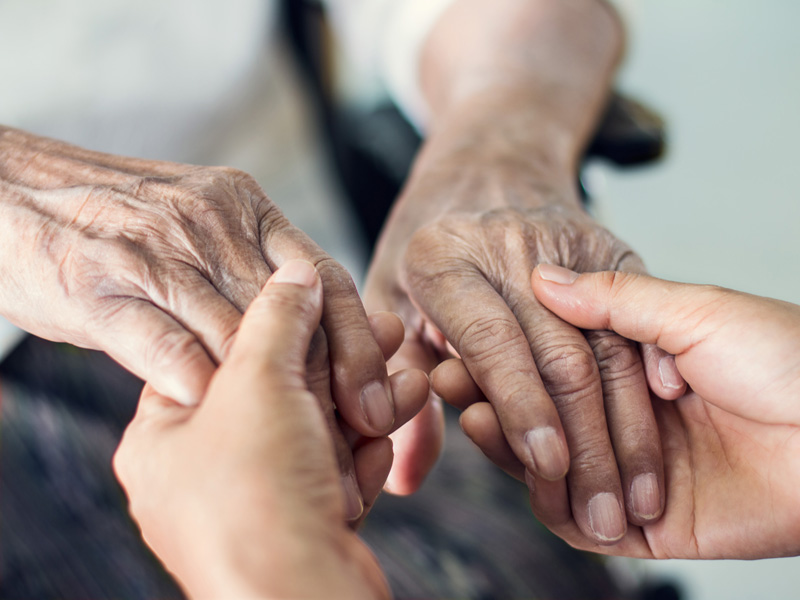“Hospice is only for the elderly.” “Hospice is unaffordable.”
These are some of the most common myths about hospice. Unfortunately, there’s a lot that is misunderstood about this kind of care. Learn the truth about hospice so you can decide if it’s right for you or your loved one.
Myth: Hospice means you are at “death’s door”
Truth: Patients who come onto hospice are those nearing death, with an expectation of six months or less to live — but this is not a definitive prediction, simply an estimate.
Most patients who come to hospice have either exhausted curative options, are tired of aggressive procedures and treatments, or have failed to thrive despite all efforts. It’s possible that people who initially look close to death may stabilize or improve a bit and may no longer be considered terminal, at which time they can be discharged from hospice.
Myth: Hospice means no other treatment will take place
Truth: Choosing hospice is choosing palliative care over aggressive care and wanting your last days to be comfortable.
Palliative care is focused on providing comfort and relief from the symptoms of an illness or disease, as opposed to curative care, which tries to reverse or halt the progression of a disease. Palliative care can be given throughout an illness.
Although hospice care may not be aggressive (tubes, diagnostics, chemotherapy, surgical procedures, etc.), it is highly skilled in providing palliative care via medications, equipment, wound care and exceptional nursing, combined with support for emotional and spiritual needs.
Myth: Hospice is a place
Truth: Hospice care is primarily provided in an in-home setting.
This could be the person’s own home, a family member’s home, an assisted living facility, a nursing home or a hospice facility. The patient chooses the setting and care is provided there. There are hospice inpatient units, but these are for very short-term stays to stabilize symptoms or provide a more clinical setting for the last few days of life.
Myth: Hospice means giving up hope
Truth: Hospice is about hope.
It may redefine what hope means. Hospice hopes a person is pain free. Hospice hopes a person can spend quality time with loved ones. Hospice hopes to provide support that enables a patient and their loved ones to be comforted, well prepared and at peace.
The word “hospice” should not be feared or mentioned in hushed tones. It should be embraced, discussed and proudly spoken of.
Myth: Hospice ends when the patient dies
Truth: Hospice is not just for the dying.
Hospice is there to support, provide resources for, listen to, counsel, problem-solve with and love the person’s circle of family and friends who surround the hospice patient. The bereavement services provided by hospice start on day one of admission and continue beyond the person’s death, for at least 13 months, but often longer.
Caregivers and family have access to this grief support to help them cope, during and after death, in the form of individual counseling or support groups.
Myth: Hospice is time limited
Truth: Situations can change, and hospice can be resumed if necessary.
Sometimes a person enters hospice and their health improves, or they simply change their minds about hospice care. If that happens, you or your loved one can discontinue hospice services.
Myth: Hospice is unaffordable
Truth: Hospice is a benefit from Medicare and Medicaid.
It is based on medical criteria for hospice care and can go beyond a six-month expectation if the patient still is medically meeting the criteria. It also remains an option after discharge from hospice by patient choice or criteria. The hospice door never closes and is not a one-time offer.
Most private insurance policies have a hospice benefit, too. They may offer options similar to Medicare or be limited by time or a financial cap.
Myth: You can’t keep your own doctor if you enter a hospice program
Truth: You can still choose to remain with your current primary care provider while on hospice care.
Myth: It is your doctor’s responsibility to bring up hospice
Truth: You, your family member or your doctor can make a referral for hospice care.
Myth: Hospice is only for the elderly
Truth: Hospice care is available to adults and children of any age who meet eligibility requirements.
Hospice represents and defines comfort care. It brings care to patients, helps eliminate hospitalization and is accompanied by emotional and spiritual support.
Learn more
…
Posted In Healthy Living, Hospice, Senior Services
